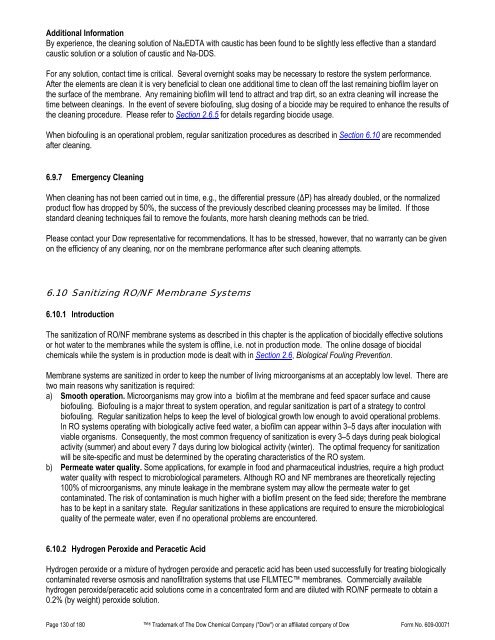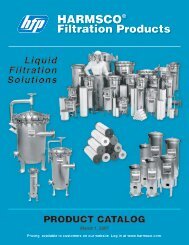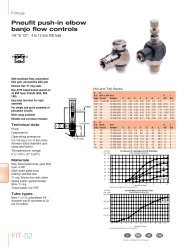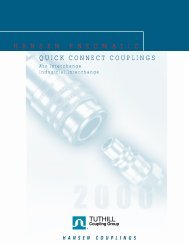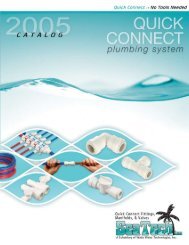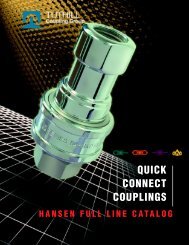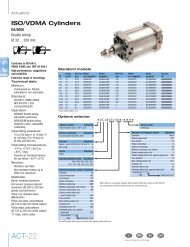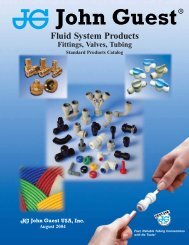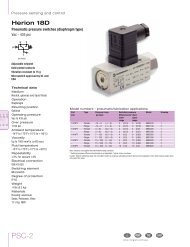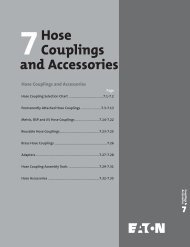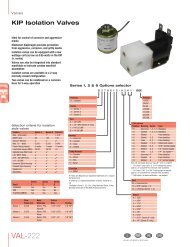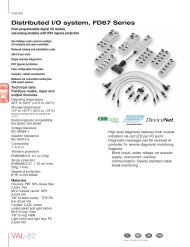FilmTec Technical Manual - Chester Paul Company
FilmTec Technical Manual - Chester Paul Company
FilmTec Technical Manual - Chester Paul Company
Create successful ePaper yourself
Turn your PDF publications into a flip-book with our unique Google optimized e-Paper software.
Additional InformationBy experience, the cleaning solution of Na 4 EDTA with caustic has been found to be slightly less effective than a standardcaustic solution or a solution of caustic and Na-DDS.For any solution, contact time is critical. Several overnight soaks may be necessary to restore the system performance.After the elements are clean it is very beneficial to clean one additional time to clean off the last remaining biofilm layer onthe surface of the membrane. Any remaining biofilm will tend to attract and trap dirt, so an extra cleaning will increase thetime between cleanings. In the event of severe biofouling, slug dosing of a biocide may be required to enhance the results ofthe cleaning procedure. Please refer to Section 2.6.5 for details regarding biocide usage.When biofouling is an operational problem, regular sanitization procedures as described in Section 6.10 are recommendedafter cleaning.6.9.7 Emergency CleaningWhen cleaning has not been carried out in time, e.g., the differential pressure (ΔP) has already doubled, or the normalizedproduct flow has dropped by 50%, the success of the previously described cleaning processes may be limited. If thosestandard cleaning techniques fail to remove the foulants, more harsh cleaning methods can be tried.Please contact your Dow representative for recommendations. It has to be stressed, however, that no warranty can be givenon the efficiency of any cleaning, nor on the membrane performance after such cleaning attempts.6.10 Sanitizing RO/NF Membrane Systems6.10.1 IntroductionThe sanitization of RO/NF membrane systems as described in this chapter is the application of biocidally effective solutionsor hot water to the membranes while the system is offline, i.e. not in production mode. The online dosage of biocidalchemicals while the system is in production mode is dealt with in Section 2.6, Biological Fouling Prevention.Membrane systems are sanitized in order to keep the number of living microorganisms at an acceptably low level. There aretwo main reasons why sanitization is required:a) Smooth operation. Microorganisms may grow into a biofilm at the membrane and feed spacer surface and causebiofouling. Biofouling is a major threat to system operation, and regular sanitization is part of a strategy to controlbiofouling. Regular sanitization helps to keep the level of biological growth low enough to avoid operational problems.In RO systems operating with biologically active feed water, a biofilm can appear within 3–5 days after inoculation withviable organisms. Consequently, the most common frequency of sanitization is every 3–5 days during peak biologicalactivity (summer) and about every 7 days during low biological activity (winter). The optimal frequency for sanitizationwill be site-specific and must be determined by the operating characteristics of the RO system.b) Permeate water quality. Some applications, for example in food and pharmaceutical industries, require a high productwater quality with respect to microbiological parameters. Although RO and NF membranes are theoretically rejecting100% of microorganisms, any minute leakage in the membrane system may allow the permeate water to getcontaminated. The risk of contamination is much higher with a biofilm present on the feed side; therefore the membranehas to be kept in a sanitary state. Regular sanitizations in these applications are required to ensure the microbiologicalquality of the permeate water, even if no operational problems are encountered.6.10.2 Hydrogen Peroxide and Peracetic AcidHydrogen peroxide or a mixture of hydrogen peroxide and peracetic acid has been used successfully for treating biologicallycontaminated reverse osmosis and nanofiltration systems that use FILMTEC membranes. Commercially availablehydrogen peroxide/peracetic acid solutions come in a concentrated form and are diluted with RO/NF permeate to obtain a0.2% (by weight) peroxide solution.Page 130 of 180 ® Trademark of The Dow Chemical <strong>Company</strong> ("Dow") or an affiliated company of Dow Form No. 609-00071


